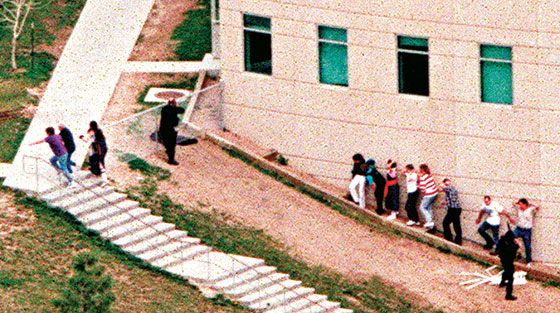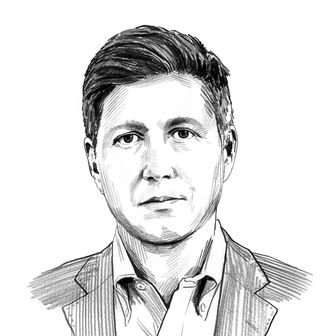
Ten years later, the Columbine High School massacre is still about nothing. Eric Harris and Dylan Klebold did not go on a killing spree because they were picked on, or because they were pagans, or because Colorado had lax gun laws. Eric was a cunning, calculating psychopath who wanted to kill as many people as possible, and Dylan was a depressive who wanted to kill himself. That is it.
Such information vacuums are dangerous, which is why the incident, memorialized in Dave Cullen’s new book, Columbine, continues to fascinate, horrify, and confuse. Confronted with the lack of recognizable human logic, we have provided our own, to make us feel better, to profit, to justify the way we see the world. If we are Christian, the shooting showed the imperative of others sharing our faith. If we were unpopular in high school, it cast a light on the dangerous petri dish of public schooling. If we believe in gun control, it reflected the recklessness of the gun lobby and our country’s frightening obsession with firearms.
But none of these things had anything to do with Columbine. It was just about two boys, stupid and vain, one dangerously charismatic, the other painfully awkward and tragically impressionable. Together, they decided that murdering as many people as possible was the only logical action; the book argues convincingly that the shock of their attack does not come from the fact that they killed thirteen people but that they didn’t kill more. Had the propane bombs they’d planted in the cafeteria gone off as planned, sending surviving students streaming out into the school’s parking lot where Eric and Dylan were waiting, they could have killed more than 500. Had not everything gone awry, in spite of their meticulous planning, they would have.
They, like most high-school kids, were motivated by nothing more than their own warped desires and limited worldview. Their sins were unforgivable but consistent with their tunneled perspective. In the wake of their murders, though, we could cop no such plea of ignorance. We should have known better. Columbine brought out the worst in everyone. The famed story of Cassie Bernall, the “She said yes” martyr supposedly killed because she professed her faith in God, was quickly debunked, but that didn’t stop publishers—who knew about problems with the story long before publication—from rushing a book by Bernall’s mom into production. (It sold over a million copies.) Cultural commentators from Jerry Falwell to Eddie Vedder took advantage of America’s hysteria to shoehorn the incident into a promotion of their own agenda. At least twelve different films have been inspired by Columbine, each with its own interpretation—from Gus Van Sant’s “They were into violent video games … and secretly gay!” in Elephant to Michael Moore’s Bowling for Columbine, which allowed Marilyn Manson to bemoan that he would have listened to Eric and Dylan, “and that’s what no one did.” Everybody had something to say, even though none of them had the slightest idea what they were talking about. I was one of them. I suspect you were, too.
I was 23 when Columbine happened, and the earliest media coverage smelled wrong. The media reports blaming “goth rock music” and wayward, nihilistic youth had the feel of Tipper Gore’s ranting about Twisted Sister. So I began researching alternative media. Back then, the website Salon.com was as alternative as this Midwesterner knew, and Cullen’s regular dispatches—which started when he was watching live cable cut-ins while eating an early lunch fifteen miles away from the school; he filed his first story from the scene nine hours later—were raw and scary and far more intuitive than what the networks were offering. Cullen discovered immediately that Eric and Dylan hadn’t even been members of the supposed “Trench Coat Mafia,” a self-dubbed group of goth kids who barely knew the duo. Furthermore, they weren’t all that unpopular. (Dylan was an avid baseball fan and played in fantasy baseball leagues; Eric, as Cullen documents, was popular with the opposite sex, particularly with a woman six years his senior.) It was bizarre, contrasting Cullen’s dispatches with the panic-stricken, alarmist “Could Your Child’s School Be the Next Columbine?” stories I was seeing everywhere else. Were these journalists at the same high school?
In his book, Cullen goes into extensive detail about just how wrong the news reports were, not only in the immediate aftermath but for months and years afterward. Part of this was due to Jefferson County sheriff John Stone, who briefed reporters for weeks with sloppy misinformation. Yet most of the inaccuracies sprung from the nature of on-the-spot, live, eyewitness reporting. The massacre itself lasted barely an hour, but news helicopters circled overhead with no information all day. That’s a lot of time to fill. So here came the Trench Coat Mafia, “She said yes,” and jock culture, theories that were cemented in the public consciousness early on and never left. “Everybody sort of gets up from the table, ‘Oh, now we’re done with that topic, and we moved on,’ ” Cullen told me recently. “Once it was over, it was over for the national media. No one [in the media] ever said, ‘We got Columbine wrong. Everyone did.’ ” At one point, Cullen talks of several national reporters who received calls from their editors alerting them to an outbreak of tornadoes in Oklahoma, sending them away and never sending them back. “It was onto the next thing, with everything still wrong,” Cullen says. Of course, the biggest tornado killed 36 people; Dylan and Eric only killed 13.
Inspired in part by my personal fascination with Cullen’s reporting, I made my own trip to Columbine, in August 2000. I was doing a piece with a co-writer for a website, and a Littleton City Council member gave us a guided tour of the area. (He wouldn’t take us to the school, so we dropped by on our own later and were on the receiving end of countless, and justified, scowls from students.) He took great pains to explain that Columbine was not, in fact, within Littleton city limits; the school just used the city in its mailing address, and journalists used it in their datelines. “Shame, people will always associate it with us,” he said. “Just a misunderstanding, really.” He was distancing himself, and his town, from the chaos. At the time, we found him pathetic, shifting his town’s responsibility for evil through semantics and zoning. Now I understand: Journalists had gotten every detail wrong, and he wanted to make sure we got that one little fact right, before we left.
What would have happened if someone had caught Eric and Dylan before April 20, 1999? Columbine argues that Eric was doomed, and that the shooting may, perversely, have stopped him from perhaps even worse atrocities down the line. (Cullen spoke with several psychologists who argue that a more mature and detail-oriented Eric could have killed thousands of people.) Dylan might have received counseling, gone off to college, and shed the ugly-duckling, suicidal tendencies of high school. Maybe, says Cullen, he would have wondered, “What was I thinking? I almost did something really crazy!” He makes the case that Dylan’s decision process, in the end, came down to two choices: “suicide, or Eric’s plan?” (Dylan kept trying to leak hints of the plan to other friends, perhaps subtly hoping to sabotage it.) It seems he chose Eric’s plan. But those are all just guesses. What happened, happened. Everything afterward is of our own invention and interpretation.
Columbine was a rare circumstance, beyond classification or easy explanation. Which is why we struggle so much trying to explain it. This is a uniquely American concept: We require answers and motivations, quickly, even if they’re ultimately wrong. We do not handle mystery and uncertainty well.
In truth, the book doesn’t have all the answers, either, and is as susceptible to revisionism and incompleteness as any historical interpretation. Randy Brown, the father of Brooks Brown, who knew both the boys (and actually was threatened repeatedly by Eric on his personal website), has trashed the book on its Amazon page for “not honor[ing] the facts or the victims.” Other reviewers have criticized Cullen for relying on secondhand information and taking leaps of conjecture. (Cullen relies heavily on psychological portraits put together by investigators.) But what the book captures better than any other reporting is the confusion and fear that come from an inability to make sense of something that has no reason, no cause, no source—confusion and fear that can lead to damaging misinformation and lasting fictions. Despite all of the coverage, we still don’t know what motivated Eric and Dylan. The best we can do—what the book is arguing for—is to stop trying to guess.
Columbine
By Dave Cullen.
Twelve. $26.99.
